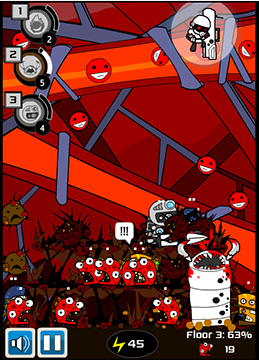Cigna is promoting the video game Re-Mission 2, the latest version of a simulation that puts young cancer patients at the center of their own treatment plans.
The insurer, which also distributed the original Re-Mission game on CD and DVD to young people with cancer in 2007, said that the latest iteration, partly available as a free mobile app, has been designed by HopeLab based on research showing how game play drives behavior.
As of August 21, the app had been downloaded 2,000 times and 10,000 game levels have been completed. Genentech, through its foundation, confirmed that it is providing a grant to support development of the next version of the game, which will be distributed to pediatric cancer institutes.
Both games were created by HopeLab, a non-profit started by Pam Omidyar, wife of eBay founder Pierre Omidyar. In the late 80s, Omidyar would relax after work as a cancer researcher by playing video games. It didn’t take long before she thought about combining work and play: creating a video game that actually helps kids fight cancer. Years later, her vision was realized when in 2006, the first iteration of the game Re-Mission was completed with help from game developer Real Time Association.
It puts players inside the body to fight against cancer withreal-world treatments like chemotherapy, antibiotics and the body’s owndefenses. “The first game was a third-person shooter type of game with20 levels; it was the kind of game you might buy or rent atBlockbuster,” recalled Richard Tate, VP of marketing & communications forHopeLab.
Researchers, reporting in a study which ran in PLOS ONE, did fMRI scans on subjects playing the original Re-Mission and found that “participatory engagement in game play (interactivity)” was activating the reward-related neural circuits in patients. Moreover, an hour of game play was just as effective as completing the game.
Armed with that knowledge, Re-Mission 2 became a different type of experience than its more serious predecessor, said Tate. “Not every person who is diagnosed with cancer is necessarily a gamer,” he pointed out. “Re-Mission 2 represents an evolution of Pam’s vision to take advantage of mini games and small mobile games—the way most people are currently playing.”
 That evolution was partly spurred by players themselves. HopeLab worked with over a dozen hospitals and 120 young cancer patients to create Re-Mission 2. Brooke Jaffe, a 21-year-old college student who was diagnosed with thyroid cancer (it was successfully removed), told MM&M: “The gameplay in Re-Mission 2 is much easier to figure out for people who might be gamers already—it’s much more akin to Angry Birds or Temple Run.”HopeLab didn’t have the luxury of distributing its first game through Blockbuster. It did, however, have the backing of Cigna, which helped get the game into the right hands.
That evolution was partly spurred by players themselves. HopeLab worked with over a dozen hospitals and 120 young cancer patients to create Re-Mission 2. Brooke Jaffe, a 21-year-old college student who was diagnosed with thyroid cancer (it was successfully removed), told MM&M: “The gameplay in Re-Mission 2 is much easier to figure out for people who might be gamers already—it’s much more akin to Angry Birds or Temple Run.”HopeLab didn’t have the luxury of distributing its first game through Blockbuster. It did, however, have the backing of Cigna, which helped get the game into the right hands.
Joe Mondy, director of public relations at Cigna, told MM&M, “We handed out enough games, so that it statistically speaking touched every kid who had contracted cancer in 2007. One of the big challenges oncologists and pediatricians have is that you’re trying to treat teenagers who sometimes naturally resist learning things and following the regime you’ve laid out for them. This game educates them without them realizing it.”
At the time however, it was still unknown what exactly the impact was on patients. HopeLabs funded a study, results of which were published in Pediatrics in 2008, showing that patients who played Re-Mission were more adherent to their treatment and had better self-efficacy. (Self-efficacy is a concept found in psychology that measures how well people believe they can complete their own goals.)
“It’s not a magic bullet,” said Tate, “but the games support them in doing their part. If you’re 13 and you’re diagnosed with cancer, you’re out of control and told all these [things] you’re supposed to do, some of which you understand and some of which you don’t. Anything that can give you information, and more importantly, a ‘sense of agency’ is a powerful tool in getting young people to engage in their care.”
Tate’s comment about a “sense of agency,” another psychological term that, roughly translated, refers to a sense of ownership over one’s actions, echoes an earlier statement by Katrina Firlik, chief medical officer and co-founder of HealthPrize Technologies: “When we enjoy what we do, we are better at being human. The doctor-patient relationship then is more open to becoming two equal humans working together to improve the human condition. Gamification promotes enjoyment which, in turn, promotes engagement, success and health.”
After evaluating the game’s impact, HopeLabs wanted to know what it is about the game that drives behavior. That desire became the basis of the PLOS ONE study. As researchers showed, “An hour of game play or less was the same as playing through all 21 levels,” said Tate. “It wasn’t just that kids were learning more, but the experience of controlling the gameplay scenario was shifting their attitudes and boosting self-efficacy. The study used fMRI machines on people playing the game vs. those watching someone playing the game. The passive viewing of information was not as effective as active game playing.”
All games are available at re-mission2.org.








